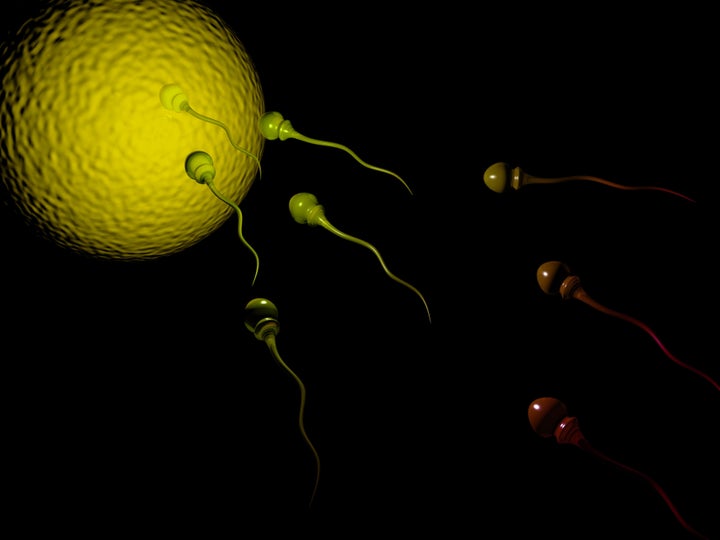
By Emily Underwood
If you're trying to avoid getting pregnant, here's another reason to mistrust the rhythm method of birth control: New research confirms that the fluid in semen, long dismissed as primarily a vehicle for sperm, contains a substance that can trigger ovulation and other pregnancy-supporting hormonal responses in female mammals. The find could lead to new fertility treatments in humans.
Like most female animals, women are spontaneous ovulators, meaning they release eggs on a fairly regular basis regardless of their sexual activity. A few animal species, however, such as camels and rabbits, release viable eggs only in response to sex. These animals are called "induced ovulators." For decades, scientific dogma has held that in induced ovulators, the physical stimulation of sex triggers hormonal responses within the female that lead to the production and release of eggs. In 1985, however, a group of Chinese researchers challenged this idea by suggesting that there might be an ovulation-inducing factor (OIF) in semen itself. According to veterinarian and reproductive biologist Gregg Adams of the University of Saskatchewan in Saskatoon, Canada, the hypothesis ran so counter to common wisdom that "people just ignored it. Me included."
When Adams and his colleagues finally tested the idea decades later, they were taken aback by their results. In 2005, the team injected the seminal fluid of male llamas—closely related to camels—into the hind legs of female llamas to see if the llamas would ovulate without genital stimulation. To their surprise, he says, injecting seminal fluid into the female llamas' bloodstream had "a very potent ovulatory effect."
That sparked a 7-year search for OIF in semen. Now, in a study published today in the Proceedings of the National Academy of Sciences, Adams and his colleagues say they've found it. The researchers took samples of llama and bull semen to see if OIF could be found in the semen of both induced ovulating species and spontaneously ovulating species. They spun the samples several times in centrifuges to separate the seminal fluid from the sperm. Sperm make up only about 5% of semen, Adams says. Then, the team used heat, various protein-digesting enzymes, and size filters to try to winnow out the effective molecule. After each treatment, they went through "a very thorough process of elimination," Adams says, injecting the altered seminal fluid into the female llamas' hindquarters to see if the molecule had survived and effectively induced ovulation, or been destroyed. To Adams's surprise, the mystery substance turned out to be a protein that's crucial to the development and survival of sensory neurons: neural growth factor, or NGF. "We were looking for an unknown protein," Adams says, but in fact OIF/NGF is a molecule found throughout the bodies of many species. "I didn't know whether to be happy or sad about that," he laughs.
NGF was discovered in bull semen in the early 1980s, Adams says, but "it was one of those dangling facts that no one knew what to do with." Now, he says, "we can connect the dots." He and his team found the same molecule in abundance in the semen of every species they've studied—including humans. In other experiments, they established that the molecule facilitates reproduction across different species: seminal fluid from boars, rabbits, and stallions, for example, induced ovulation in female llamas, and seminal fluid from llamas induced ovulation in prepubescent mice. Although NGF does not appear to induce ovulation in the other spontaneous ovulator they studied, the cow, it has other fertility-boosting effects. Here, it changes the timing of the development of egg-bearing follicles, and promotes the development and function of the corpus luteum, a temporary endocrine structure crucial to sustaining pregnancy.
As the first evidence that NGF, or OIF, from semen travels throughout the female body, acting as a hormone, Adams says "this is really new for us.” Going forward, the team plans to study how NGF affects human fertility. "We're really interested to know the relationship between OIF and infertility," he says. "Are males with high concentrations of OIF in their semen more fertile?" For couples who are having a difficult time getting pregnant, he says, perhaps OIF treatments could be developed.
This research is "very exciting," says Sergio Ojeda, a neuroscientist at Oregon Health & Science University in Portland who studies how neurotrophins—the class of proteins that includes NGF—act within the female reproductive system. Scientists have wondered whether this type of NGF, which was once thought to act in only sensory areas of the nervous system, also plays a role in reproduction. The new study, he says, indicates that NGF in male sperm actually travels through the female bloodstream to the brain, causing her hypothalamus and pituitary gland to release the hormones required for pregnancy. Although the precise mechanisms by which NGF is acting on the pituitary gland and hypothalamus still need to be worked out in detail, Ojeda says the research itself looks solid. The beauty of this study, he says, "is what is exciting about science. They decided to find out what the molecule was with no preconceived ideas at all. When they found it, it was extremely well done."
ScienceNOW, the daily online news service of the journal Science